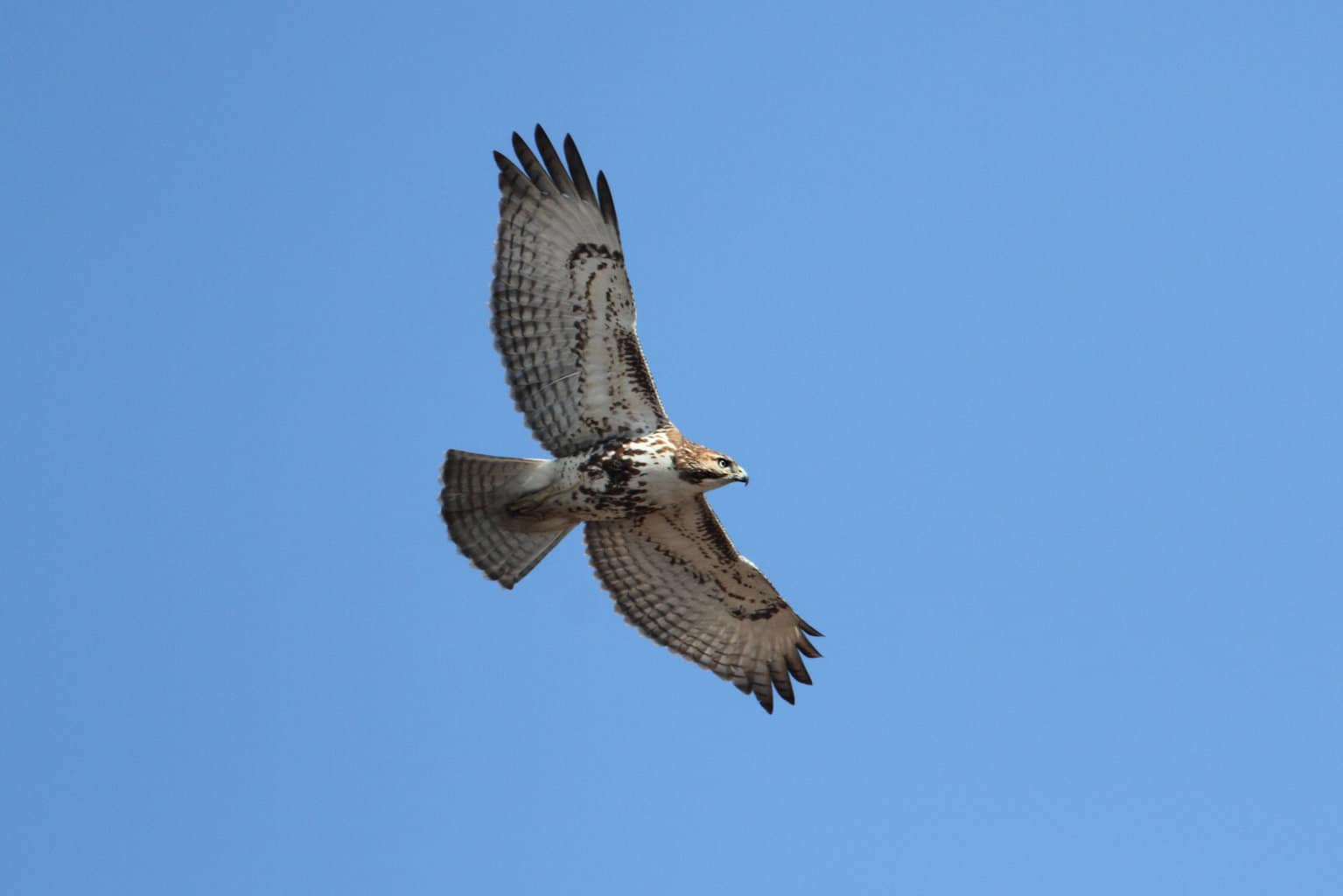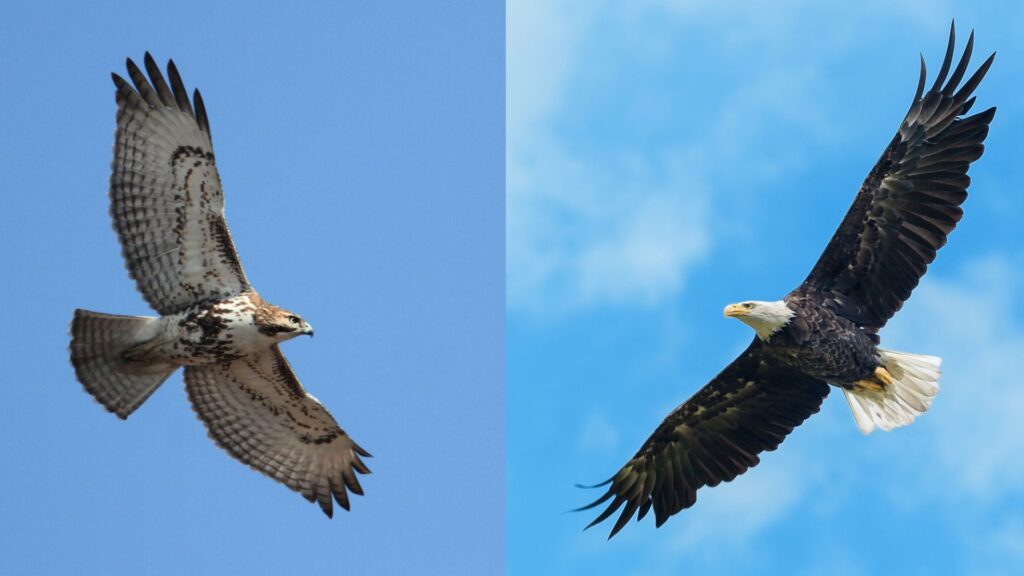Eagles and hawks and falcons–oh my! These majestic birds have a lot in common, from their sharp, curved beaks to their equally sharp talons.
All of them are birds of prey, meaning they hunt for their food, and all of them have exceptional eyesight to help them in their hunt. Maybe you’ve heard the expressions “eagle eyed” or “watching me like a hawk”?
But if we have three different words for these birds, then there must be some kind of difference between them, right? Absolutely!
In this article, we’re going to break down the differences between eagles and hawks–two different members of the same family. We’ll also touch a bit on what makes them different from falcons.
You can learn more about that in our Falcons vs. Hawks article. [Editor: please link the Falcons vs. Hawks article here once it is posted]
What’s the Difference Between a Hawk, Eagle, and Falcon?
Eagles, hawks, and falcons are all birds of prey with similar appearances, and as such, it can be easy to confuse them. On top of that, many people will sometimes casually use these words interchangeably.
Hawks and eagles belong to the same family, the Accipitridae. They are both birds of prey that primarily kill with their sharp talons. The biggest difference between them is their size and the size of the prey that they can hunt.
Eagles are large birds of prey that can hunt vertebrates larger than about 50 centimeters (close to 20 inches) in length. These larger species of bird have a wide prey selection from ample prey populations.
While most of their diet is prey like rabbits or fish, they can take down large animals like deer, bighorn sheep, wolverines, bobcats, or seals. They also eat other raptors, like hawks, falcons, and owls.
Hawks hunt smaller prey and are themselves smaller in size. They eat mammals, like mice, rabbits, squirrels, and voles. But they also eat small birds, snakes, lizards, frogs, and insects.
Falcons, however, belong to their own family, the Falconidae. They have thin, tapered wings specially designed for flying at high speeds and rely on this speed to hunt.
Their diet is mainly smaller birds. They hunt in the air and kill with their beaks rather than their talons. They are potential threats to many animals in different habitat types.
Is an Eagle Considered a Hawk?
Eagles and hawks are different but belong to the same family of birds, the Accipitridae. This family includes eagles, hawks, harriers, and kites.
The Accipitridae belong to the order Accipitriformes, which means “having the form of a hawk” in Latin. So, in a way, that makes an eagle like a hawk. But it’s not a type of hawk, just closely related.
Which Is More Powerful: A Hawk or an Eagle?
Eagles are larger and heavier than hawks and have wider wingspans. By definition, they can take down bigger and stronger prey than hawks can.
For their size, hawks are no pushovers! But eagles are definitely more powerful and would likely win in a fight against a hawk. Eagles will also eat hawks, especially smaller hawks.
What Bird Could Defeat an Eagle?

Bald Eagles and Golden Eagles are both apex predators, sitting on top of the food chain. That means healthy adult individuals don’t have to worry about other animals hunting them.
That’s not the case for sick, injured, or juvenile eagles, though–animals that can find an opportunity to prey on those eagles will do so. They see them as potential prey.
But when it comes to birds who could tangle with an eagle and potentially win the fight, there are a few. Larger birds defending their young have been known to fight off eagles. In one unexpected case, a Common Loon actually stabbed a Bald Eagle.
Some owls would be big enough to give eagles a hard time, such as a Great Horned Owl–a large and territorial bird that likes to feed on other raptors.
Birds that cooperate could also succeed in driving away an eagle, if not exactly “defeating” it. Crows are one bird well-known for their “mobbing” behavior, where they will attack a large predator from all sides, harassing it mercilessly until it leaves their territory.
They may do this to protect a food source, such as a carcass, or to protect their nests and young. Magpies and Blackbirds are examples of other birds that will use this tactic.
Eagles will generally flee such an attack. Individually, each crow is not a threat, but together they could cause serious injury. Adult males have a diversity of prey, and they have rounded tails.
They aren’t the great airborne attackers that falcons are, so fighting back isn’t really an option. But eagles can fly higher than crows, so simply leaving and finding an easier meal is the better option.
Do Eagles Eat Hawks?
Eagles definitely eat other birds, and that includes hawks. It’s more common for an eagle to eat hawk eggs or very young hawks because they’re easier for meals. Eagles also eat carrion, so if they find a hawk already dead, that’s a potential meal too.
A full-grown hawk will put up a fight, and if an eagle can find a meal that’s less of a hassle, that’s what it will take first. Their shorter tails differentiate them from other types of birds.
In general, if an eagle is large enough compared to the hawk in question, there’s a possibility that it will try to eat the hawk. Hawks, in turn, will eat other birds that are smaller than they are.
There was one very unusual case, though, where a pair of Bald Eagles were observed raising a Red-Tailed Hawk chick–a species they would normally eat, given the opportunity!
Is a Golden Eagle a Hawk?
No, a Golden Eagle is not a hawk but a specific eagle species living in North America. It breeds in the far northern regions of Alaska and Canada, then migrates south into the continental United States.
It’s also found year-round west of the Rocky Mountains in the US and southern parts of Canada.
Golden Eagles are named for the golden-colored sheen on their feathers. They prefer open country around mountains, hills, and cliffs.
These big hunters can take down prey as large as deer, mountain goats, or even bobcats. Usually, they will eat smaller prey like rabbits or squirrels, though.
Golden Eagles can have wingspans wider than 85 inches and weigh as much as 13 pounds. Their ability to take down large prey puts them firmly in the category of eagles rather than their smaller hawk relatives.
How Can You Tell a Juvenile Eagle?
In North America, there are two native species of eagles: Bald Eagles and Golden Eagles. These two are easy to tell apart as adults because Bald Eagles have distinctive all-white heads.
But juvenile Bald Eagles don’t have those white head feathers and look much like Golden Eagles. They have brown bodies mottled with white. While it can be hard to tell them apart by appearance, the range can help.
East of the prairies, Golden Eagles, are rare, and your sighting is much more likely to be an immature Bald Eagle.
Juvenile Golden Eagles, on the other hand, are larger than their Bald Eagle counterparts, with long wings. They have large white patches on the undersides of their wings and tails, and their golden napes have started to grow.
How Can You Tell if a Hawk Is a Juvenile?

There are many more North American hawk species than eagles, so going over all of their markings wouldn’t be helpful.
Juvenile hawks generally have more muted plumage than their adult counterparts, often in lighter shades of brown and white, with streaking on their undersides.
There can also be an eye color change, usually from a lighter color to a more intense one. For example, juvenile Red-Tailed Hawks have a yellowish eye that changes to a dark red-orange in adulthood.
Juvenile Cooper’s Hawks also have yellow eye, which goes through an orange phase and red.
It can help to start with your location and the season. What should hawks be in your area at this time? After narrowing down the options, you can start comparing adult and juvenile markings to get a better match.
Soaring Above It All
When it comes down to it, there aren’t a lot of differences between eagles and hawks: basically, just their size!
These closely-related birds of prey aren’t too hard to tell apart, though, because, in North America, there are only two species of eagles to identify.
Now that you know who rules the skies head out and see if your sight is keen enough to spot these sharp-eyed birds!

